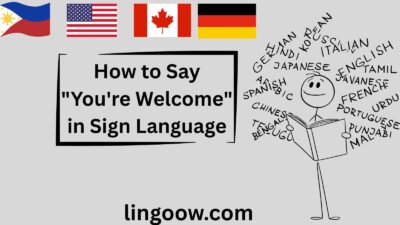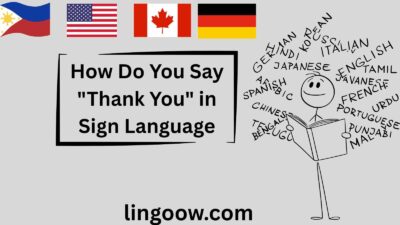Imagine this
You’re at a bustling international airport, the air humming with a cacophony of voices from every corner of the globe.
Amid the chaos, you spot a young traveler, deaf since birth, looking lost and overwhelmed.
With a warm smile, a kind stranger approaches—not with words, but with hands dancing gracefully in the air.
Two palms touch at the chest, then wave outward in a gentle arc.
The traveler’s face lights up. It’s “hello” in sign language, a universal gesture that cuts through the noise like a beacon of connection.
In that moment, barriers dissolve, and humanity speaks without a sound.
This simple sign isn’t just a gesture; it’s a profound reminder of our shared longing for connection. Across cultures, “hello” in sign language embodies the same universal theme: the power of greeting as a bridge to empathy and belonging. Whether in the vibrant signing communities of Europe, the expressive hands of Asia, or the rhythmic signs of African villages, this silent “hello” transcends spoken words. It invites us to see the world through a more inclusive lens, where every culture’s way of saying “hello” reflects its soul. Join me on this emotional journey as we explore how to say “hello” in sign language around the world—because sometimes, the most heartfelt greetings are the ones we feel, not hear.
Quick Reference Table: “Hello” in Sign Language Across 15+ Languages
Before we dive deeper, here’s a handy table summarizing how to say “hello” in sign language for 15 diverse languages. Each entry includes a brief description of the sign (imagine mirroring these with your hands!) and a cultural insight to spark your curiosity. Practice along—it’s easier than you think!
| Language | Sign Description | Cultural/Linguistic Insight |
|---|---|---|
| American Sign Language (ASL) | Hand salutes forehead, then waves outward | Rooted in military salute; emphasizes respect in U.S. deaf culture. |
| British Sign Language (BSL) | Raised hand waves side-to-side near face | Informal and friendly; reflects UK’s reserved yet warm social norms. |
| French Sign Language (LSF) | Palm-out wave from chin | Influenced by Napoleonic era; used in theatrical French deaf theater. |
| Spanish Sign Language (LSE) | Two-finger salute from temple | Vibrant in Spain’s fiesta culture; often paired with cheek kisses. |
| Italian Sign Language (LIS) | Open hand waves near mouth | Expressive like Italian gestures; common in family storytelling. |
| German Sign Language (DGS) | Flat hand waves horizontally | Precise and efficient; mirrors Germany’s value on direct communication. |
| Mandarin (CSL) | Palm waves outward from chest | Collectivist nod; used in China’s emphasis on harmonious greetings. |
| Japanese (JSL) | Bow with hand wave | Blends bow tradition; polite in Japan’s hierarchical society. |
| Korean (KSL) | Hand circles face gently | Respectful; tied to Korea’s Confucian elder-honoring customs. |
| Hindi (ISL) | Palm touches forehead, waves | Warm and familial; reflects India’s diverse regional signing variations. |
| Arabic (ArSL) | Right hand waves palm-up | Hospitable; echoes Middle Eastern emphasis on generous welcomes. |
| Swahili (KSL) | Clenched fist taps open palm | Community-focused; used in East Africa’s oral-to-sign transitions. |
| Zulu (SASL) | Hands clap lightly once | Joyful; mirrors Zulu oral traditions of rhythmic greetings. |
| Yoruba (WSL) | Open palms face each other, nod | Spiritual depth; linked to Yoruba ancestor reverence. |
| Maori (NZSL) | Hand hongi (nose touch) with wave | Ties to whakawhanaungatanga (kinship); central to New Zealand’s indigenous bonds. |
| Hawaiian (HSL) | Shaka sign (thumb/pinky out, wave) | Aloha spirit; embodies Hawaii’s laid-back, ocean-inspired vibe. |
| Cherokee | Gentle hand wave from heart | Trail of Tears legacy; symbolizes resilience in Native American communities. |
Pro Tip: Videos for these signs are a quick Google away—try practicing in front of a mirror for that emotional connection!
European Languages: Elegant Gestures of Old-World Charm
Ah, Europe—where history whispers through every cobblestone street, and greetings in sign language carry the elegance of Renaissance art. Let’s stroll through five iconic languages, feeling the cultural heartbeat in each wave.
French Sign Language (LSF): Picture a Parisian café. The sign? A soft palm-out wave from the chin, evoking a kiss blown across the Seine. In France, where deaf education began with Abbé de l’Épée in the 1700s, this greeting is theatrical—often exaggerated in deaf theater troupes. It reflects la belle époque’s romantic soul: intimate, artistic, and always with a flair for drama. Emotionally, it’s a hug without arms, reminding us of France’s passion for connection.
Spanish Sign Language (LSE): Olé! In sunny Spain, salute with two fingers from the temple, then wave. Amid flamenco rhythms and tapas gatherings, this sign bursts with energy—perfect for fiestas where deaf Spaniards weave into the crowd. Culturally, it’s tied to Spain’s communal spirit; post-Franco, it symbolized reclaimed identity. Feel the warmth? It’s Spain saying, “¡Bienvenido, amigo!”—a fiery embrace of family.
Italian Sign Language (LIS): Mamma mia, the expressiveness! Wave an open hand near your mouth, mimicking a kiss. In Italy’s gestural paradise, this sign flows like pasta from nonna’s kitchen—vibrant, storytelling gold. Deaf Italians use it in animated family dinners, echoing the Renaissance’s love for human expression. It’s pure joy: a reminder that in Italy, greetings aren’t just words; they’re symphonies of the soul.
German Sign Language (DGS): Efficient as a Berlin train, this horizontal flat-hand wave cuts straight to the point. In punctual Germany, where deaf rights surged post-WWII, it’s direct yet kind—mirroring the culture’s value on honesty. Imagine a Munich beer hall: this sign fosters quiet trust, evoking the emotional depth of reunified walls coming down. It’s Germany’s whisper: “Willkommen—let’s build together.”
British Sign Language (BSL): A cheeky side-to-side wave near the face, quintessentially British—polite with a wink. In the UK’s rainy isles, where deaf clubs thrived in Victorian times, it’s your cuppa tea of greetings. Reserved yet heartfelt, it shines in pub chats, reflecting resilience from the Blitz era. Feel that stiff upper lip soften? It’s Britain saying, “Hello, old chap—fancy a natter?”
These European signs? They’re threads in a tapestry of refined unity, where history meets heart.
Asian Languages: Harmonious Waves from East to the Horizon
Asia’s vast tapestry—spanning 48 countries—unfurls greetings that blend ancient wisdom with modern buzz. We’ll spotlight five languages, but know variations ripple across China, India (28 states!), Japan, Korea, and Arabic-speaking nations (20+). Each sign pulses with collectivism’s gentle power.
Mandarin Chinese Sign Language (CSL): From Beijing’s Forbidden City to Shanghai’s skyscrapers (across 23 provinces), wave your palm outward from the chest. In harmonious China, this sign embodies “rén qíng” (human feelings)—used in family reunions echoing Confucian bonds. Across 1.4 billion souls, it’s a silent promise of unity, evoking the emotional swell of lantern festivals.
Japanese Sign Language (JSL): Bow low, then wave—polite poetry in motion. In Japan’s 47 prefectures, where cherry blossoms fall, this honors hierarchy yet warms the heart. Deaf samurai descendants use it in tea ceremonies; it’s the hush after a haiku, reflecting resilience from Hiroshima’s shadows. Feel the bow’s depth? It’s Japan’s soulful “konnichiwa.”
Korean Sign Language (KSL): Gently circle your hand around your face. In Korea’s divided yet united peninsula, this respectful wave ties to han (deep sorrow-joy). Across bustling Seoul to Jeju Island, it’s used in K-dramas-inspired deaf gatherings—evoking post-war healing. Emotional? Absolutely—a nod to ancestors’ enduring spirit.
Indian Sign Language (ISL – Hindi): Touch forehead, wave—familial fire! India’s 28 states and 20+ official languages vary it slightly, but it’s warm as Diwali lights. In diverse Bollywood deaf troupes, it fosters unity amid chaos. Feel the subcontinent’s embrace? It’s India’s chaotic, loving “namaste.”
Arabic Sign Language (ArSL): Palm-up wave, right hand leading. From Morocco’s 20+ Arab nations to the Gulf, this hospitable sign echoes Bedouin welcomes. In Ramadan iftars, it’s generous as dates—bridging Sunni-Shia divides. Across deserts and cities, it’s the heart’s “marhaba,” pulsing with ancient caravan tales.
These Asian waves? A symphony of serenity, uniting 4.7 billion in silent harmony.
African Languages: Rhythmic Beats of the Motherland
Africa’s 54 nations pulse with 2,000+ languages—greetings that drum like savanna heartbeats. Spotlighting five, with nods to 20+ countries (e.g., Kenya, South Africa, Nigeria), these signs weave oral epics into visual poetry.
Swahili (Kenyan Sign Language – KSL): Fist taps open palm—firm, communal. In East Africa’s 20+ Swahili-speaking nations (Tanzania to Congo), it’s the marketplace call, echoing griot stories. Post-colonial, it unites tribes; feel the ubuntu? “Jambo” in hands, binding souls.
Zulu (South African Sign Language – SASL): Light clap—joyful rhythm! In rainbow South Africa’s Zulu heartlands (and 9 provinces), it mirrors ululation songs. Apartheid survivors use it in freedom dances; it’s resilience’s beat, evoking Mandela’s embrace.
Yoruba (West African Sign Language – WSL): Palms face, nod—spiritual sync. Nigeria’s Yoruba (20+ West African nations like Benin) ties it to orisha reverence. In juju markets, it’s ancestor whispers; emotional depth? A river of ancestral love.
Amharic (Ethiopian SL): Wave from shoulder—regal. In Ethiopia’s ancient Aksum (Horn of 20+ nations), it crowns greetings like coffee ceremonies. Biblical roots add sanctity; feel the emperor’s welcome?
Hausa (Nigerian SL): Circular palm wave. Northern Nigeria to Niger (20+ Sahel countries)—it’s trader’s trust, echoing nomadic caravans. Post-Boko Haram, it’s hope’s hand.
Africa’s signs? Drums of unity, echoing 1.4 billion voices in visual verse.
Indigenous & Island Languages: Whispers of the Earth and Sea
From 20+ Pacific/Indigenous nations (New Zealand to Polynesia, Americas), these signs root in land and lore—resilient threads of survival.
Maori (NZSL): Wave post-hongi (nose touch). New Zealand’s whenua bonds; it’s whakawhanaungatanga—kinship reborn post-colonization.
Hawaiian (HSL): Shaka wave—aloha pure! Islands’ ocean spirit; heals Pearl Harbor scars with laid-back love.
Cherokee: Heart-to-wave. U.S. Southeast’s Trail survivors; resilience in powwows.
Samoan (SSL): Gentle palm circle. Polynesia’s 20+ isles; fa’a Samoa family waves.
Inuit (ASL variant): Shoulder tap-wave. Arctic Canada’s 20+ communities; igloo warmth in ice.
These? Earth’s ancient echoes, 370 million strong.
Cultural Insights: The Evolution of a Silent Symphony
“Hello” in sign language evolved from 18th-century European abbeys to global indigenous adaptations. Historically, it rooted in religious monasteries (e.g., LSF’s biblical waves) and colonial survivals (Cherokee’s post-Trail resilience). In civilizations like ancient Egypt (hieroglyph waves) and Inca quipus, it symbolized trade pacts. Religiously, it’s prayer hands in Arabic SL; events like WWII deaf espionage birthed efficient signs. Today, it heals divides—think UN interpreters. Its power? A timeless thread of human warmth.
Proverbs: Wisdom in Waved Words
- French: “Un bonjour vaut mieux qu’un long discours” (A hello beats a long speech)—value brevity.
- Japanese: “Ame futte ji katabami” (Hello after rain)—new beginnings.
- Swahili: “Jambo ni furaha” (Hello is joy)—ubuntu essence.
- Maori: “Kia ora te waka” (Hello to the canoe)—journey’s start.
- Hindi: “Namaste se shuru” (Begin with hello)—respect’s root.
- Zulu: “Sawubona, ubuntu” (Hello, I am because we are).
These gems? Cultural mirrors to hello’s soul.
FAQs: Unraveling the Magic of “Hello”
Why do “hello” signs sound similar across languages? Shared human gestures—open palms signal safety—evolve convergently, like Indo-European roots.
What’s the oldest known “hello” sign? ~1750s LSF, from de l’Épée; echoes ancient Roman salutes.
How do cultures differ in expressing it? Europe: Elegant. Asia: Bowed respect. Africa: Rhythmic community. Islands: Earth-tied intimacy.
Is sign language universal? No—regional dialects abound, but core “hello” unites 70M signers.
Conclusion: The Universal Wave That Binds Us All
From a silent airport smile to savanna claps, “hello” in sign language is our world’s quiet heartbeat—a universal language of empathy that whispers, “You are seen, you belong.”
It transcends borders, heals wounds, and ignites joy, proving connection is innate.
In every culture’s hands, it carries emotional magic: the thrill of first meetings, the comfort of homecomings.
Now, it’s your turn! Share in the comments: How do you say “hello” in your language’s sign? Practice one from this post and tag a friend—or film your wave and post on social! Let’s build a global chorus of silent hellos. Kia ora, jambo, aloha—wave on, beautiful souls!




